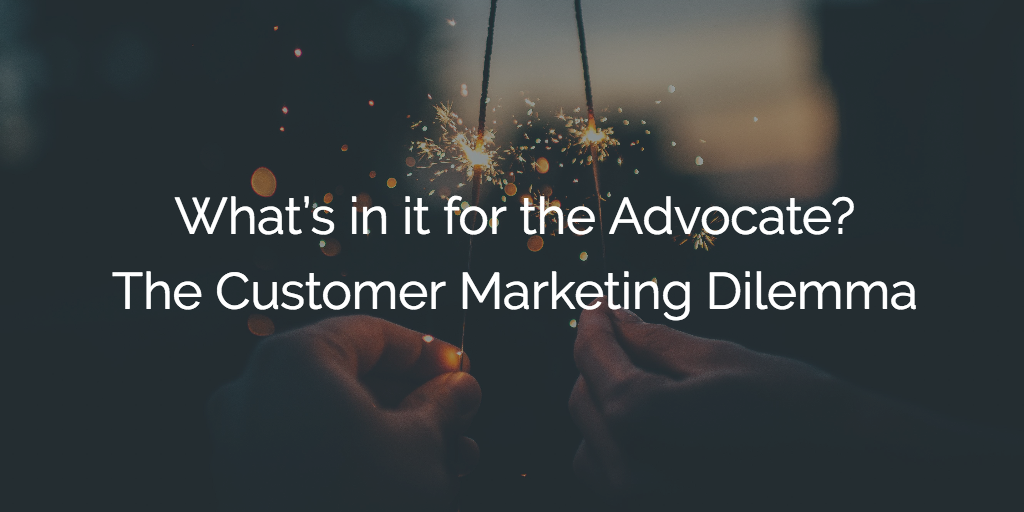When I started drafting this, I was flying back from Pulse Europe where I delivered a couple of sessions on Customer Marketing (Advocacy).
This is a very popular topic in the Customer Success ecosystem right now, as many Customer Success programs are working to figure out the right ways to calculate their ROI and track how they’re adding value for their businesses. In the Helix Model of Revenue Growth, the ability of Customer Success to contribute to new logo growth is a key pillar of the value of Customer Success, and Customer Marketing is the lever to help make and track that impact.
There’s a very fundamental question I always get when speaking about Customer Marketing. Why would a customer want to advocate? What’s in it for them? In both of the sessions that I delivered at Pulse Europe, I received variations of this question.
I see LOTS of practitioners and executives get stuck here. Most often, I think “what’s in it for them?” questions stem from experiences in which a vendor struggled because they:
- didn’t effectively position the value advocacy brings to the customer and not just to the vendor → see the “What’s in it for the customer?” section.
- didn’t make the request to a customer in an effective way → see the “How do you effectively make a request?” section.
- received negative feedback after an advocate didn’t feel respected → see the “Areas to be careful” section.
There isn’t a silver bullet, but I’ll offer here a variety of strategies I’ve found effective to push through this ambiguity.
What’s in it for the customer?
1.Building brand—for the person and their company. As a customer marketer, you have a very valuable asset to offer through case studies, webinars, and speaking events: publicity. This is valuable to the customer at two levels: the company level and the human level.
At the company level, you’re showing how innovative and forward-thinking your customer is and how that ties to your customer’s mission. I’ve found this is particularly important for SMB customers, who are excited to build brand awareness and re-market the content as validation that they’re fast-growing and cutting-edge.
At the human level, you’re showcasing someone’s leadership. A person bet their dollars, hours, and name that your product was the right choice to achieve a desired outcome. Or perhaps they’ve inherited that bet from someone else. Advocacy is a way for them to very humbly and publicly say:
- I am a smart business person who can make challenging decisions.
- Look at the value that my decisions and leadership are bringing to the company.
- If you are a smart business person, you should also consider this product.
A and B are very valuable for the advocate. C is very valuable for the vendor.
2. Professional advancement. This ties in closely with the point above. A well-crafted case study, webinar, or speaking event that showcases an advocate’s leadership, decision making, and value can be a key towards a promotion. I find this point particularly resonates with Director and VP-level people that are trying to rise to the VP– or C-level.
Early in the process, ask your advocate about their goals for the project and do your best to make them shine. What do they want the final asset to “say?” What are their desired take-home points? As a Customer Marketer, it’s your job to show how your product served as a means to that end. Many of your advocates will be proud of what they’ve achieved, and a great asset should be something they feel proud to share internally.
How do you effectively make a request?
1. Make it very easy to say “yes.” And make it easy for them to say “yes” in your first email. This is a principle that applies broadly throughout business and certainly holds true when coordinating advocacy. People want to say “yes.” But people will often say “no” (or won’t respond) if there’s a need to exert effort to understand your request, or if something appears unorganized, or if it appears it could backfire on them.
Let’s say you’re asking a customer to co-lead a webinar. Here’s an email that I believe is ineffective:
Subject: Gainsight Webinar
Dear John,
We are coordinating a series of customer-led webinars for February. I spoke with your CSM and they thought you would be a stellar fit. Would you be open to this?
Best,
Will
What’s the topic? How long? Do I need to make the slides? Ambiguity makes it easier for the recipient to either directly say “no,” or to kick off a long email chain. Email chains are undesirable because there are many opportunities for an email to not get responded to (sometimes intentionally, sometimes not).
Here’s an example of an email that I find much more effective:
Subject: Opportunity to be Showcased in a Gainsight Webinar
Dear John,
I lead the Customer Marketing team at Gainsight. Your CSM mentioned to me that you’re using Gainsight to help onboard customers, particularly with Success Plans.
I would love to showcase this use case in a Gainsight webinar. Our webinars are usually 40 mins long (25 mins content, 15 mins Q&A) that are broadcasted to both customers and prospects. I have slots open on February 7 @ 9 a.m. PT and February 14 @ 9 a.m. PT, and I could collaborate with you on slides.
Are you interested in being showcased in the webinar? Let me know if so and I’ll follow up with next steps.
Best,
Will
At this point, it’s very easy for the recipient to say “yes.” Sometimes, I’ll go so far as to even suggest a title and abstract in the initial email.
2. Tie the request to a compelling event. This can be an industry event, like Pulse. It can also be a customer lifecycle event, like an EBR, Launch, or even an Promoter NPS Response. Compelling events increase response rates because you have a more authentic reason to reach out and the customer is already thinking about you.
Also, by tying certain types of requests to repeatable lifecycle events, it’s easier to scale the process and recruit effort from other process-oriented functions throughout the company, like Customer Success. Adding a referenceability check, a case study survey, or just a pointer to an Influitive hub into certain Lifecycle Playbooks are all low-friction ways for Customer Success to help you grow.
3. Leverage what’s already been done. If an advocate has already agreed to some form of case study, the incremental effort to make other assets that reuse that narrative is much lower. For example, at our Pulse Conference, I coordinated a track of nine Enterprise Showcase sessions. Executives from some of our largest customers got on stage and presented slides on their Customer Success strategy, how they were using our product, and the types of value it was driving.
Ahead of Pulse, I leveraged their upcoming presentations as a compelling event to ask for a video testimonial at the conference. Since they were already planning to be on-site and already understood their narrative, the incremental effort was just to sit for the interview. Eight of the nine execs from the Enterprise track agreed, and I also booked eight customers from other presenter tracks for 16 total.
We had a professional video crew in a hotel room upstairs to make the recordings, and my colleagues and I rotated as the interviewers. It was chaotic and stressful. But we completed 16 recordings, and after cutting, editing, and maintaining a healthy dose of persistence over the coming months, 15 of them were approved. Many of them now live on our homepage.
More recently, we’ve been able to leverage the content again by running a series of Showcase Webinars with some of these same customers. The success rate for these requests is quite high, because they’ve already made the slides and they already understand the narrative. They just need to present the content.
Having invested in developing their narrative and slides for Pulse, they needed to spend much lower effort to participate in subsequent video testimonials and webinars. In turn, we were able to position them as thought leaders and experts in the field, which has a positive impact on their personal brand and career.
Areas to be careful:
BE CAREFUL #1: Not being authentic. For example, don’t disguise a request for a customer to take a sales reference call as “networking.” I have tried this and while I’ve never lost an advocate because of it, I have been called out. I’ve found that advocates can see through this strategy easily, eliciting a metaphorical (or maybe literal) eye-roll. Advocates like it when you’re open that they’re advocating, even if they’re not expecting anything tangible in return.
BE CAREFUL #2: Pushing too hard. Examples include: 1) trying to extract ROI points they aren’t comfortable sharing, 2) asking for too many references…. usually no more than one request per month, 3) checking in too frequently on approvals for a case study, etc.
Particularly when it comes to understanding a customer’s ROI, it’s my job to ask questions, poke, and prod during a case study call. I want to help craft the best, most impactful story for both of us. If you ask a question and get a hard “I can’t answer that,” respect it. If you get a “I’ll need to check,” it’s totally fine to follow up in an email.
BE CAREFUL #3: Telling your story, instead of their story. I receive a myriad of input from Sales, Marketing, Sales Enablement, and Product Marketing about the message our case studies should give. This is all very valuable input to consider. Keep in mind, it is given through the lens of “what does our business need.”
It is the Customer Marketer who has the greatest insight into what the customer wants it to say. And it is up to her or him to balance these two. That’s one of the biggest reasons we believe Customer Success should “own” Customer Marketing. Take a look at this blog post to read my argument in-depth.

